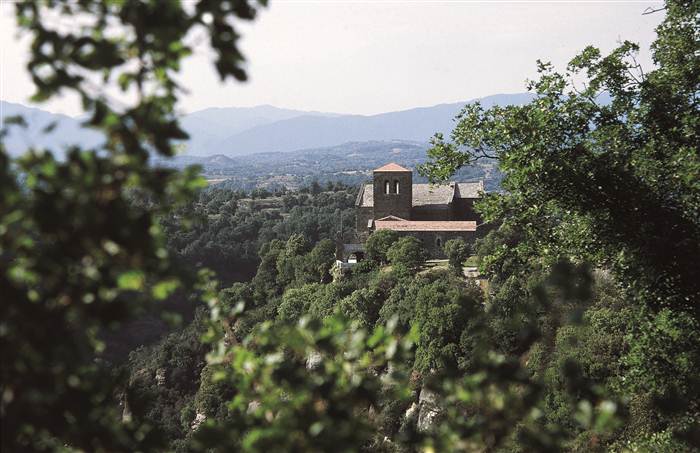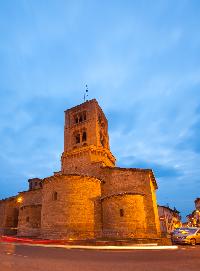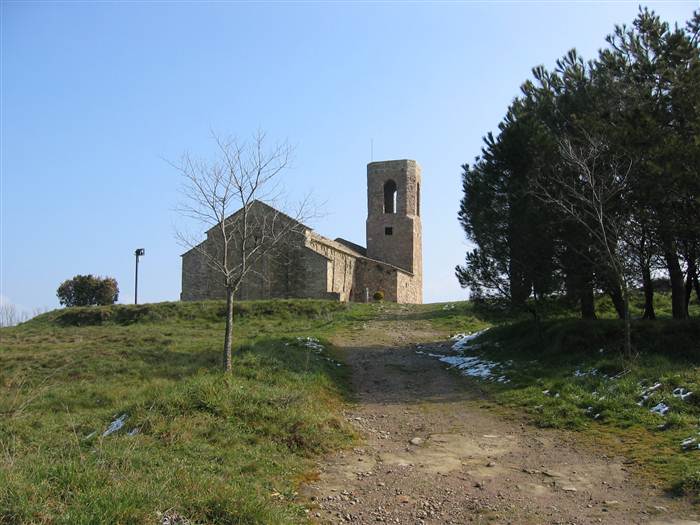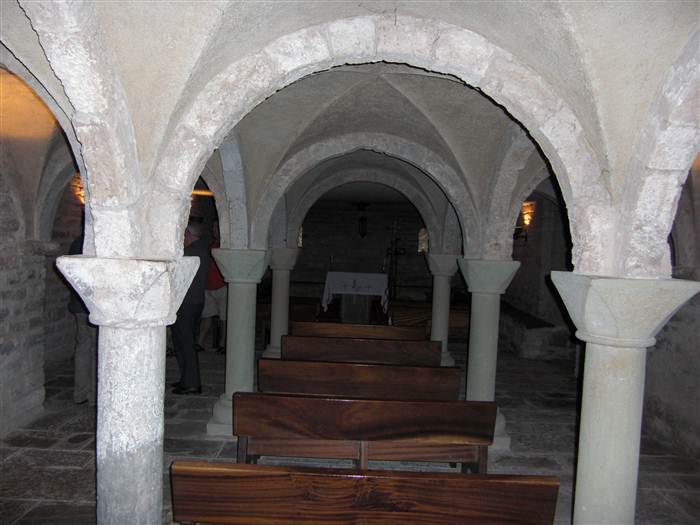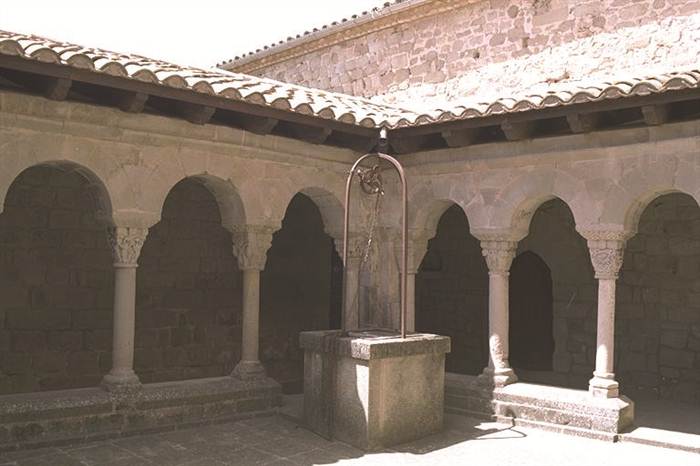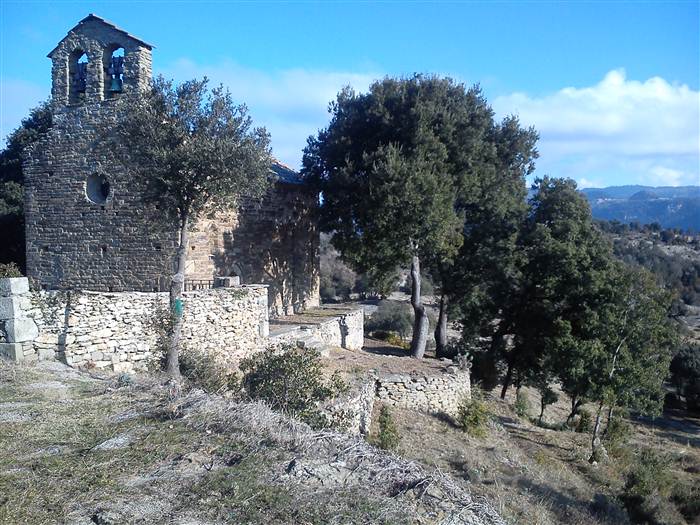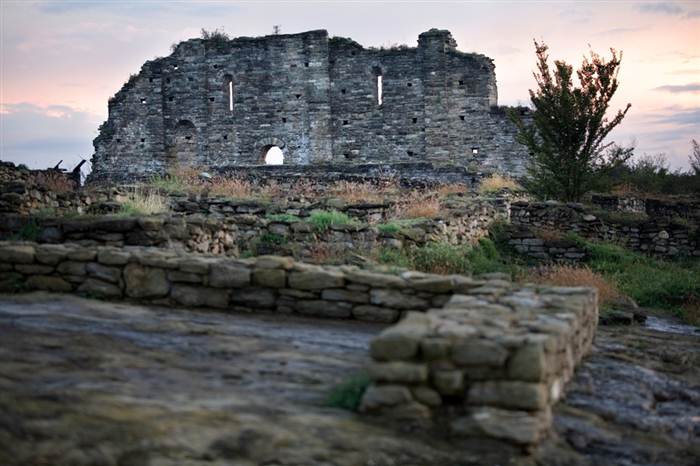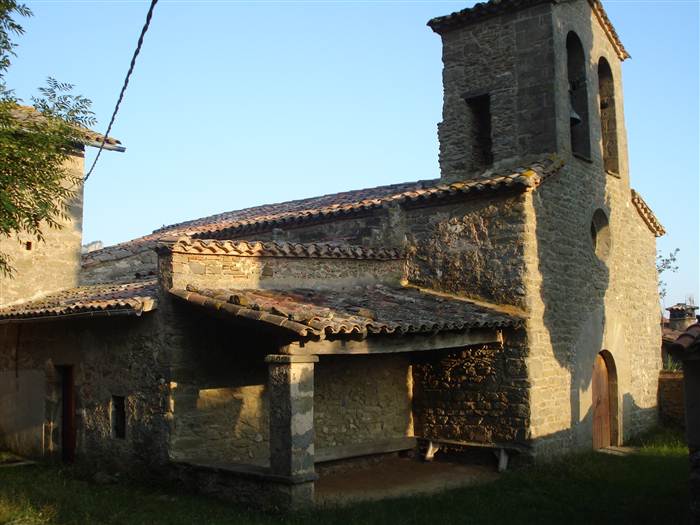Romanesque period

The county of Osona is one of the richest in the whole of Catalonia for Romanesque art. Here there are more than ninety buildings that to varying degrees display elements of the Romanesque style.The Romanesque architecture here tends to reflect the Lombard style prevalent in the 11th century
The trails presented here aim to show visitors these noble monuments, which despite their humble appearance in some cases, as a whole illustrate a period of splendour which stretches from the turn of the 11th century to the 13th century.
You can also find more information on the architectural and artistic heritage of the Bishopric of Vic at www.cataloniasacra.cat
The ten Osona Romanesque routes are:
The Episcopal Museum, Vic
The Episcopal Museum of Vic is a distiguished museum amongst all museums of catalonia due to the fact that it is more than a century old and also because of the quantity and quality of its collection. It contains some 20.000 exhibits, most originating from various sectors of the diocese of Vic, which were originally collected by Bishop Josep Morgades.
The cathedral bell tower and crypt
Vic Cathedral is a mixture of styles ranging from the Romanesque to the neoclassical. The Romanesque bell tower dates back to the mid 11th century
and is a prototype of the Lombard style introduced into the county by BishopOliba. The Romanesque crypt was consecrated together with the cathedral in
1038.
The Queralt Bridge
This was constructed in the 11th century and marks the old road to Barcelona, which was actually built over an old Roman road.
Albergueria
This space was used to receive pilgrims in the Middle Ages as they crossed
Europe. Following painstaking restoration work, the Albergueria is now an
exhibition centre and an important cultural centre of the Bishopric of Vic. Exhibition room visit times: Wednesday to friday from4.30 pm to 7.30 pm.
public holidays from 11 am to 2 pm
More information: Tél. 938 891 857, albergueria@bisbatvic.com
This was built in the 11th century although only a part of the outer walls now remains due to the demolition of the building in 1882. Formerly it had been used as a place of residence by the chief magistrate, as seat of the Royal Bar,
as the city granary and as a prison. Visiting times: Tuesday to Saturday from 11 amto 1 pm and from 6 pm to 8 pm;Sundays/public holidays from6 pm to 8 pmSant Sixt
It was constructed in the style of the 11th century and has undergone modifications over time. The most important of these was the construction of the apse and the incorporation of the bell tower during a later period.
Sant Esteve de Tavèrnoles
This magnificent example of the Romanesque style was built in around 1083 and was given a new façade in 1728. The attractive bell tower and the exterior decoration of the apse are particularly noteworthy.
How to get there: it’s the middle of the city Tavèrnoles.
Sant Pere de Savassona
This building was constructed in around 1060 and has remained virtually intact since then, with the sole addition of a loft to protect the vault and a new doorway on the west side after the sealing off of the south doorway.
How to get there: from Tavèrnoles continue on road BV-5213 in Sant Pere de Casserres until there is a deviation to the right shows the church.
Sant Feliuet de Savassona
How to get there: from Tavèrnoles following the BV-5213 management
Sant Pere de Casserres until there is a deviation to the left. It should
leave the car and follow the route indicated on foot.
Formerly a Benedictine monastery, this church is situated in the district of Les Masies de Roda, at a very pronounced bend in the river Ter, which is now partly surrounded by the Sau Reservoir. Casserres was formerly a castle (although there are records of a Church of Sant Pere in the mid 10th century) and once belonged to the Viscounts of Osona-Cardona, who founded a monastery there in around 1005.
Visiting times: from 16th September to 28th February from 11 am to 5.30 pm; from 1st March to 14th June from 10 am to 5.30 pm; from 15th June to 15th September from 10 am to 7 pm. Closed on Monday. Second fortnight of January closed for holidays.
Further information: tel. 937 447 118 – 608 892 200;
santperedecasserres@ccosona.net, www.santperedecasserres.cat.
How to get there: BV-5213 and continue until the Parador de Vic-Sau, there is a road to the left leads to the monastery.
Santa Eugènia de Berga
This church was built in the mid 11th century and was extended in the 12th with the addition of a transept, dome, bell tower and doorway. It was consecrated in 1173 and declared a national monument and site of cultural interest in 1931.
Visit times: mass is held on Sunday at 10.30 am and on Saturday at 8 pm. For visits at other times please call Santa Eugènia de Berga Town Council on 0034 938 855 803.
How to get there: take the B-520 road from Vic to Taradell. The town of Santa Eugènia de Berga is situated 3 km from Vic. The church is situades in the town centre.
The bell tower of the Church of Sant Genís de Taradell
All that remains of the Church of Sant Genís, which was originally built in 1076, is the belltower, which was restored after the civil war under the direction of Puig i Cadafalch. It has a square base and consists of five storeys. There is reproduction of it in the Poble Espanyol,in Barcelona.
Visit times: mass is held on Eves of a Holiday at 8 pm and on Sunday at 11.30 am. For further information call Taradell Town Council on 938 126 100.
How to get there: take the B-520 out of Santa Eugènia de Berga towards Taradell, located about 3 kilometres away. The church is situated in the town centre.
The Chapel of Sant Quirze de Subiradells
Records of this building date back as far as 989. It was reconstructed in 1095 and is made up of a single nave with a semicircular apse covered by a barrel vault.
Visit times: for further information ring Taradell Town Council on 938 126 100..
How to get there, take the Taradell-Viladrau road and once on it take the turn-off on the left to La Roca residential estate. The chapel is near a large square onthis estate, overlooking the Sant Quirze Stream. It can be reached by car
Sant Jaume de Viladrover
This building dates from the turn of the 12th century, although the apse was restored at the turn of the 20th century. It became an independent parish in 1878.
Visit times: during mass, which is held on Saturday at 8 pm or on the first Sunday of the month at 12 noon. For visits at other times call the priest of Sant Miquel de Balenyà on 938 870 047.
How to get there, take the Balenyà-Seva road (BV-5303). As you leave Balenyà there is a turn-off to the right that is clearly signposted and which leads directly to the church. It can be reached by car.
Santa Maria de Seva
Records of this church, which was rebuilt in the 12th century, date back to 952. In the 17th century the apse was removed and the nave was lengthened to include more side chapels.Visit times: during mass, which is held on Eves of a Holiday at 8 pm, or on publicholidays at 11.30 am. For visits at other times call the priest on 938 898 359 or on 650 928 021.How to get there: take the same road that has brought you to Balenyà, the BV-5303. Once you reach Seva the church is situated in the town centre.
Sant Martí del Brull
This church was consecrated after 1057 and consists of a single nave, although it used to have three apses. In the 12th century a portico was added to the south façade and the apse was decorated with the figure of the Pantocrator, which is now housed in the Episcopal Museum in Vic
Visit times: during mass, which is held on Eves of a Holiday at 7 pm, or on public holidays at 12 noon. For visits at other times call the priest on 938 898 359 or on 650 928 021.
How to get there: on leaving Seva you will find a sign indicating the way to El Brull on the BV-5301. Once you reach El Brull the church is situated in the town centre.
Sant Vicenç de Malla
Built around 1078, this church consists of three apses and a bell tower. Following an accurate reconstruction of the church, the main apse was strengthened with reinforced concrete.
Visit times: during mass, held on Sunday at 11 am, or go to the parish office on Saturday from 5 pm to 6.30 pm (next to the church). For further information call 649 267 993.
How to get there: from Vic, take the C-17 towards Barcelona and turn off at Malla centre (exit 55).
Lourdes de Tona
Records of this church date back to 1011 when it was known as Santa Maria del Barri. It was rebuilt in the 12th century, although all that now remains of the original structure is the semicircular apse, with its quarter spherical vault, and the square four-storey bell tower.
Visit times: it is usually open. For further information ring Tona Town Council on 938 870 201.
How to get there: take the C-17 towards Barcelona and turn off at Tona north (exit 52). Once in the town signs point you towards the church.
Sant Andreu del Castell de Tona
Visit times: to arrange a visit ring Tona Town Council on 938 870 201.
How to get there: a path leads from the Church of Lourdes in Tona up to the summit where the medieval complex is situated. It is easy to reach by car but on days when no event is being held in the castle a chain prevents vehicles from getting past, in which case one must arrive on foot (some 7 minutes).
The original building, records of which date back to 951, was replaced by a Romanesque building in the 11th century, which in turn underwent additional structural alterations in the baroque period.
Visit times: Please ask for the key at the Vilageriu country house, tel. 938 870 716.
How to get there: from Tona take the road that goes from Collsupina to Moià. After about 500 metres there is a turn-off to the left that indicates several masies (country houses) and the Chapel of Sant Miquel de Vilageriu. This is an isolated building located next to crop fields. It can be reached by car.
Formerly known as Sant Fruitós de Balenyà. Records of this church date back to 955. Alterations to the building started early on, in the 12th century, with the construction of a bell tower that remains almost intact, with the last section being added in the Gothic period.
Visit times: it is always open.
How to get there: return to the C-17 road and turn off at Hostalets de Balenyà (exit 47). Once in the town follow the directions to the cemetery. It can be reached by car.
Records of this church date back to 1007. The Romanesque building was partially replaced by another in around 1640 and there were later reforms which left only the apse intact, while the nave and doorway were totally altered.
Visit times: mass is held on the town’s Main Festival Day (Sant Jaume, 25th July) and on All Saints’ Day (1st November). For visits on other days please contact Sant Martí de Centelles Town Council on 938 442 406.
How to get there: continue on the C-17 towards Barcelona and turn off at Sant Martí de Centelles. Follow the signs to reach the church and pass Abella Bridge to reach l’Oller country house. It can be reached by car.
Sant Martí de Riudeperes
Records of this church go back to 1050. It underwent modifications in the 12th century when a doorway was built into the western wall, as well as an atrium or porch, which now forms part of the building.
Visit times: weekends at 9.30h . For visits at other times contact on 649284074 .
How to get there: take the Calldetenes exit from the C-25 (transversal arterial road) but to get to the church travel towards Sant Julià de Vilatorta on the BV-5201. The church is situated on the right-hand side of the road. It can easily be reached by car.
Sant Julià de Vilatorta
Records of this church date back to 927. Extensions and modifications began to take place from the 12th century. The most important reforms were completed in 1592 when two openings were made in the central nave. An arch was constructed on either side of the nave to incorporate the two additional lateral aisles.
Visit times: contact the parish office (open on Monday and Thursday from 5.30 pm to 6.30 pm) or Sant Julià de Vilatorta Town Council on 938 122 179.
How to get there: from Sant Martí de Riudeperes continue towards Sant Julià de Vilatorta (BV-5201 road). The church is situated in the town centre.
Santa Maria de Vilalleons
This church was consecrated in 1083. In the 13th century an atrium was added due to the destruction of the Romanesque doorway. Only the archivolts of the doorway remain and these frame the rose window on the west wall.
Visit times: For further information, contact Sant Julià de Vilatorta Town Council on 938 122 179.
How to get there: take the local road out of Sant Julià de Vilatorta towards Vilalleons (BV-5202 road) and after 4 km you reach the cluster of houses and the church. It can easily be reached by car.
Sant Sadurní d’Osormort
This parish church has been in existence since 937 and was rebuilt in the 11th century. In the 12th century an atrium was added with a solid tower or bell tower.
Visit times: it can be visited during mass, on Saturday at 7.30 pm. For visits at other times, contact Sant Sadurní d’Osormort Town Council on 938 887 375 (Monday from 11 am to 1 pm and from 6 pm to 8 pm; Thursday from 7 pm to 10 pm).
How to get there: once again take the C-25 (transversal arterial road) towards Girona and turn off at exit 195 (Sant Sadurní d’Osormort). The church is situated at the roadside just as you reach Sant Sadurní.
Sant Vicenç d’Espinelves
This church originally dates from the 11th century but was given a second nave and apse and consecrated in 1187. Inside the church the original doorway, part of which was transferred to the nave added in the 12th century, can still be seen.
Visit times: during mass on public holidays at 12 noon. For visits at other times please contact the priest on 938 849 163.
How to get there: take the C-25 once again towards Girona and turn off at exit 199 (Espinelves). The church is right in the middle of the town.
Santa Maria de Folgueroles
Records of this church date back to 967. During the 12th and 13th centuries the nave was modified and lengthened on the west side with the addition of an atrium.
Visit times: during mass, Saturday and Eves of a Holiday at 8 pm and Sunday at 12 noon. For visits at other times please contact the parish office, located in Plaça Mossèn Cinto Verdaguer, 5, tel. 938 122 317.
How to get there: take the Folgueroles exit from the C-25 (transversal arterial road). Take the N-141D towards Folgueroles. The church is right in the middle of the town.
Sant Llorenç del Munt
Although it gave its name to a castle estate in the year 886, the existence of this church was not recorded until 1012. The building consists of a nave covered by a vaulted archway with a semicircular apse to the east.
Visit times: to arrange visits please contact M. Dolors Farrés on 649 131 172 or on 938 852 510.
How to get there: from Folgueroles take the N-141D towards Vilanova de Sau – Pantà de Sau (Sau Reservoir). Once you pass through the Mina Tunnel there is a track on the right that leads directly to Sant Llorenç. It is possible to get almost all the way to the church in a four-wheel drive vehicle; alternatively it can be reached on foot.
Santa Maria de Vilanova de Sau
Documents relating to this church first appear in a list of parishes between 1025 and 1050. The original building was replaced at the end of the 11th century.
Visit times: mass is held on Sunday at 10 am. For visits at other times ring 938 847 093.
How to get there: on leaving Folgueroles, take the N-141 towards Vilanova de Sau – Pantà de Sau (Sau Reservoir). The church is right in the middle of the town.
Sant Romà de Sau
Only the tip of the bell tower can be seen since the valley was flooded to construct the Sau Reservoir, although records of Sant Romà date back to between 1025 and 1050. The original church was replaced by another that was consecrated in 1061 – 62.
Visit times: this depends on the water level of the reservoir.
How to get there: from Vilanova de Sau take the Embassament de Sau (Sau Reservoir) turn-off (N-141D). Once you reach the dam you must cross it and follow a path leading to La Riba until you get to the Yacht Club, from where the church may already be visible, depending on the reservoir water level. It can easily be reached by car.
Sant Esteve de Granollers de la Plana
This church was consecrated in 1088 and consists of one nave, completed to the east by a semicircular apse. The nave is covered by a barrel vault, reinforced by two transversal arches and modified by the construction of chapels on the north and south sides.
Visit times: during mass, held on Sunday at 11 am or during the parish office opening hours (Saturday from 5 pm to 6 pm). For visits at other times please ring 938 863 140.
How to get there: take the Manlleu exit on the C-17. Continue along the Vic to Manlleu road (B-522) and take the Sant Esteve de Granollers de la Plana turn-off. It can be reached by car.
Sant Julià de Vilamirosa
The first records of this church date back to 1040. Various alterations were made to it during the 17th and 18th centuries.
Visit times: ring the Culture Area of Manlleu Town Council on 938 506 666 Monday to Friday from 8 am to 3 pm.
How to get there: from Sant Esteve de Granollers de la Plana there are about 3 kilometres. Continue along the B-522 towards Manlleu and at the entrance to the town (just opposite the petrol station), take the turn-off on the left and go along the track (300 metres) that leads to the church. The church can be reached by car.
Sant Vicenç de Torelló
The existence of this church has been known since 1059. It was extended in 1624 with the addition of the south-facing atrium to form a second apse and the insertion of a west-facing door.
Visit times: mass is held on Sunday at 12 noon, on Saturday at 8 pm and on weekdays at 7 pm. A guided tour can be arranged beforehand by ringing the Town Council on 938 590 003 or the Paisatges del Ter Tourism Consortium on 938 504 915.
How to get there: go through Manlleu following the signs indicating Torelló (BV-5224 or C-37 Vic – Olot road). The signs will lead you to Sant Vicenç de Torelló. The church is situated right in the middle of the town.
Sant Julià Sassorba
Built at an altitude of 786 metres, in a peaceful setting, this church was first mentioned in 902. A new church was built by the parishioners in around 1091 and in the 18th century the main apse was replaced by a square presbytery.
Visit times: during mass, first and third Sunday of the month at 1 pm. For visits at other times please ring 938 850 890.
How to get there: there are 11 kilometres from Vic to Sant Julià Sassorba. Take the C-154 road towards Olost – Prats de Lluçanès. There is a turn-off on the right-hand side of this road indicating the way to the church. It can be reached easily by car.
Cripta de Sant Andreu d’Oristà
Records of the church date back to 923, but it was not until 1969 that the Romanesque crypt was discovered and exposed after being covered and damaged during work completed in the 18th century.
Visit times: mass is held every Sunday at 12 noon and on Eves of a Holiday at 9 pm. To arrange a visit at other times ring 938 128 030.
How to get there: continue along the C-154 towards Olost until you reach the Oristà turn-off. The church is right in the middle of the town. It can be reached easily by car.
Sant Andreu de Llanars
Records of this church date back to 1034. The actual building is small with a nave and a semicircular apse to the west.
Visit times: please contact Prats de Lluçanès Town Council on 938 560 100 / 938 560 732.
How to get there: there are about 16 kilometres from Sant Andreu d’Oristà. Take the road towards Prats de Lluçanès (B-433) and continue along the B-4404. Then take the B-432, go through the town and carry on towards Navàs on the BV-4401 road. A sign appears just before the turn-off. It can be reached easily by car.
Santa Maria de Lluçà
Records of this church go back to 905. In around 1168 it was converted into a small monastery or canonical priory. The 12th century Romanesque cloister with 22 capitals on simple columns is particularly noteworthy.
Visit times: mass is held on Sunday at 11.30 am. Alternative visit times are Wednesday to Sunday from 11 to 1.30 pm; Saturday and Sunday from 4 pm to 6 pm. For further information ring 938 530 130.
How to get there: from the town of Prats de Lluçanès head towards Berga (C-154 road) and along the B-4341 road. Once you reach Lluçà, the church is situated at the entrance to the town. It can be reached by car.
Sant Vicenç del castell de Lluçà
Records of this castle date back to 988. It consists of a circular nave, of which there are few in Catalonia, with a semicircular apse on the east side.
Visit times: ring 938 530 130.
How to get there: from Santa Maria de Lluçà take the B-4341 for 500 metres until you reach the turn-off for the church. Apart from the turn-off sign, there is another one on the path. You must park in the car park of an abandoned country house and complete the route to the church on foot (about 15 minutes).
Sant Julià de Cabrera
Ses origines remontent au XIe siècle. L’édifice roman fut sérieusement endommagé par les tremblements de terre de 1425-1427. Malgré les nombreuses modifications subies, il conserve une partie de sa structure originelle qui consiste en une nef couverte par une voûte en berceau.
Visites messe le dimanche des Rameaux à 13 h. Pour visiter les autres jours, téléphoner au curé de Rupit, tél nº 630 116 954.
Comment y arriver : prendre la C-25 (Eix transversal) et sortir à Roda de Ter. Suivre ensuite la C-153 en direction de Rupit. Après l’Esquirol et le pont de les Perxes, un chemin sur la gauche mène à l’église en 3 km. Accessible en voiture.
Sant Llorenç Dosmunts
Datant du XIIe siècle, l’édifice est en grande partie conservé car seule l’abside romane fut supprimée et remplacée par un chœur rectangulaire au XVIIe siècle.
Visites : une messe a lieu le 10 août, pour la saint Llorenç. Pour visiter les autres jours, téléphoner au curé de Rupit, tél. 630 116 954.
Comment y accéder : de Sant Julià de Cabrera, suivre la C-153 en direction de Rupit. L’église se trouve avant d’arriver à Rupit et on y accède par un petit chemin qui part à gauche avant la mairie. La voiture arrive jusqu’au croisement pour l’église mais le chemin qui y mène doit être fait en 4X4 ou à pied.
Sant Joan de Fàbregues
Édifice roman d’une nef, trois absides et une coupole. Il existait déjà en 968. L’église fut refaite au XIe siècle et modifiée après les tremblements de terre de 1427.
Visites : une messe a lieu le 24 juin à 12 h, pour la saint Joan. Pour visiter les autres jours, téléphoner à l’entreprise Anigami (qui gère aussi l’hébergement à côté de l’église), tél. 937 447 295.
Comment y accéder : de Sant Llorenç Dosmunts, aller en direction de Rupit, 3 km. Passer Rupit et suivre une route goudronnée qui mène à l’église Sant Joan de Fàbregues. Accessible en voiture.
Sant Julià de Cabrera
Ses origines remontent au XIe siècle. L’édifice roman fut sérieusement endommagé par les tremblements de terre de 1425-1427. Malgré les nombreuses modifications subies, il conserve une partie de sa structure originelle qui consiste en une nef couverte par une voûte en berceau.
Visites messe le dimanche des Rameaux à 13 h. Pour visiter les autres jours, téléphoner au curé de Rupit, tél nº 630 116 954.
Comment y arriver : prendre la C-25 (Eix transversal) et sortir à Roda de Ter. Suivre ensuite la C-153 en direction de Rupit. Après l’Esquirol et le pont de les Perxes, un chemin sur la gauche mène à l’église en 3 km. Accessible en voiture.
Sant Llorenç Dosmunts
Datant du XIIe siècle, l’édifice est en grande partie conservé car seule l’abside romane fut supprimée et remplacée par un chœur rectangulaire au XVIIe siècle.
Visites : une messe a lieu le 10 août, pour la saint Llorenç. Pour visiter les autres jours, téléphoner au curé de Rupit, tél. 630 116 954.
Comment y accéder : de Sant Julià de Cabrera, suivre la C-153 en direction de Rupit. L’église se trouve avant d’arriver à Rupit et on y accède par un petit chemin qui part à gauche avant la mairie. La voiture arrive jusqu’au croisement pour l’église mais le chemin qui y mène doit être fait en 4X4 ou à pied.
Sant Joan de Fàbregues
Édifice roman d’une nef, trois absides et une coupole. Il existait déjà en 968. L’église fut refaite au XIe siècle et modifiée après les tremblements de terre de 1427.
Visites :L’église de Sant Joan de Fàbregues est ouverte du mercredi au dimanche de 10h à 18h. La Saint-Jean est le seul jour où la messe est célébrée.
Comment y accéder : de Sant Llorenç Dosmunts, aller en direction de Rupit, 3 km. Passer Rupit et suivre une route goudronnée qui mène à l’église Sant Joan de Fàbregues. Accessible en voiture.
tornar enrere








